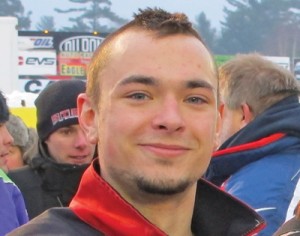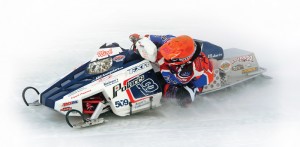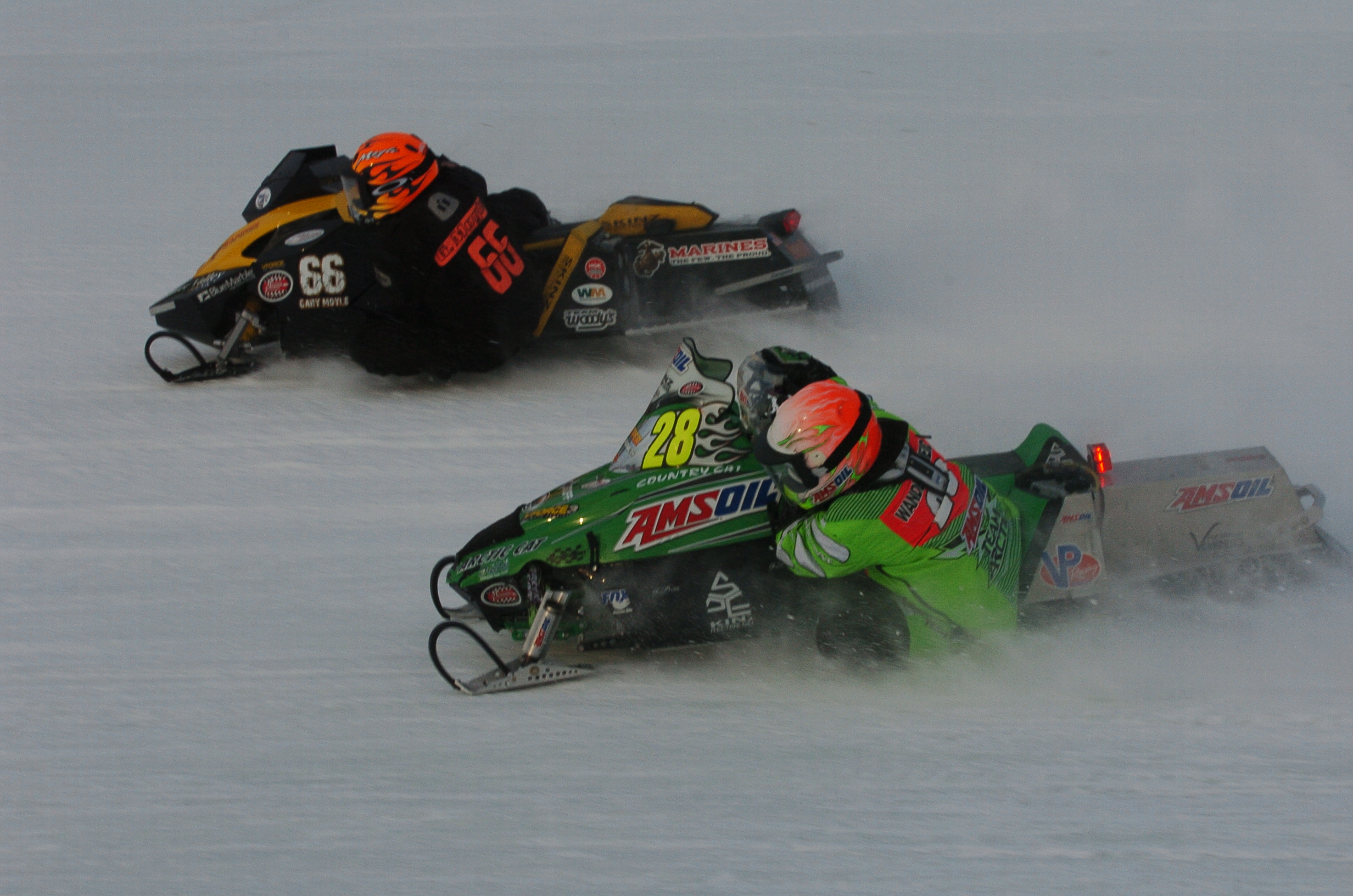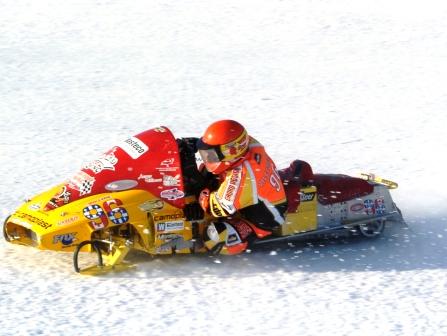
In January, 21-year-old Nick Van Strydonk of Tomahawk, Wisconsin, used a dramatic last-corner pass to earn more than $20,000 and have his name written into the history books by winning the 49th annual Eagle River World Championship Snowmobile Derby. While he may not be as familiar in snowmobiling pop culture as Tucker Hibbert or Levi LaVallee, Van Strydonk has been actively racing on ice oval tracks for 17 years — since he was 4 years old.
In the March issue of Snow Goer, we published excerpts from this interview. Here on snowgoer.com, we present the full interview.
SNOW GOER: What causes you to get involved in snowmobiling in the first place?
NICK VAN STRYDONK: Dad and I were doing rentals when I was about four years old up in the Minocqua area, and we hopped in the truck and were on our way home after picking up some sleds up there and we looked across the lake and it looked like there were some little kids racing. So Dad swung in there and kind of looked around a little bit. We got the info and found out that, every weekend, parents brought their kids down, and after you pay your entry fee the kids get to run the sleds around all day. Each one was stock, so you just show up with your helmet and your gear on and you race for the day, and you’d go home with a goodie bag. We didn’t really care about the trophies at that time, because the goodie bags were the tickets I guess.
The first weekend I went there we won the class and then went back the next weekend. Pretty soon Dad’s got the gears running and trying to figure out how to make them go faster and moving up in the ranks. He started designing things, and it was pretty much history from there. … My family owns Erv’s Sales & Service in Tomahawk, so I’ve been around snowmobiles all my life and started riding them when I was 3 and a half. Dad and I would go across the lake together, just putting around. Then we started racing and we get to do our passion together.
SG: With racing being so central to your winter, do you ever get a chance to just go trail riding?
NVS: I get a chance every now and then to trail ride, Dad and I get to go sometimes for a little bit. My girlfriend and I go quite a bit more than he and I do, but when we have snow, yeah, I like to go. I try to put 300 to 500 miles on (per season). I know a lot of guys that are into snowmobiling are going to say, “Well, that ain’t nothing,” but between being gone Thursday to Monday [racing] and then working during the week, we really don’t have much time to go out and play.
SG: It seems like a lot of younger guys these days are drawn to the big air of snocross racing, but you’ve stuck with ovals. Why?
NVS: I did a little bit of both – there were times where I would race snocross and then turn around and run an oval race [on the same day]. I originally started out in motocross so that’s why I kind of got interested in snocross, with the jumps and the turns and things like that. But I think Dad’s and my passion is really in ovals. We knew that snocross would eventually lead to broken bones and not really being able to have a really good living standard toward the end of the career so we figured ovals was the better ticket.
SG: That said, certainly people can get seriously hurt in oval racing – it’s certainly not for the weak-kneed either.

NVS: No, between being scrunched over on the sled and getting minor bumps and bruises, what has happened the most is dinging up the knees and hitting them on the ice and things like that, and cramping from sitting in a [tight] position. But, a few years ago at Eagle River I ended up fracturing a vertebra in my neck and last year I broke my back and three ribs. It definitely takes its toll, but I like to say in oval racing, when you crash, you kind of do it all in one shot, like once a season. In snocross you can crash a couple times a week. We’d rather just get it all out of the way at once [laughs]. Yeah, it’s definitely got some danger, and we know that when we strap the helmets on. Above all things, I just make sure I come out walking at the end of the day. That’s pretty much the focus that all the riders have.
SG: For all the trail riders who have never raced or even been to a high-speed oval race like Eagle River, can you describe what it feels like to be flying down the straight away and then pinching the sled off in the turns?
NVS: The best way I can describe it, from a trail standpoint, is take your sled out on a lake, hold ‘er wide open for maybe 300 yard or so, then try to turn, with slowing down and having a bunch of weight transfer from the back of the sled to the front. Your inside ski is going to want to raise or high-side, as we call it. Then you’ve got to fight to hold the sled down – it’s 375-plus pounds, so my 135 pounds has to hold the sled down to get through the corner at 65-70 mph. That’s probably the best way to describe it.
SG: So how does somebody get from driving a stock Kitty Cat to being the sport’s World Champion at Eagle River? Tell us your path.
NVS: Like I said, I started out on Kitty Cats and eventually moved up from the stock Arctic Cat to Improved Kitty Cat, which was a little governor tweak here and there. We didn’t have 120s when I started, so from there it grew to the[Kitty Cat] F-IIIs, which was a modified engine and a pipe and a stock Kitty Cat chassis. From there it was to full-blown F-1s, which is a modified chassis and the bottom end of the Kitty Cat [engine] but you had a whole bunch of improvements – the pipe and [engine mods] and everything that goes with it. That was pretty much the Champ class of the Kitty Cat racing world – the F-1. A lot of F-1s were designed to look like the old factory Arctic Cat race sleds or the RXL or whatever race sled of the day. Then from there we moved right into the 340s, ran those for a few years, and then into the Improved 440s or the Sprint class with USSA, starting with a 340 [class engine] with a pipe and a race chassis. From there you moved to Semi-Pro and Pro 600 [Sprint], which was a fan-cooled 600 with a race chassis. Then we moved to Semi-Pro Champ, which is a liquid-cooled 440 engine in that same race chassis, that’s what the big guys are running – the only difference between the Semi-Pros and the Pros is the experience level. So we ran that a year and got the go-ahead to go do it in Pro. We ran in Pro and I ended up qualifying the first year for the World Championship [in 2009].
SG: So we were already on a Champ sled at age 17?
NVS: Yeah, we had to petition pretty hard for it. I don’t want to sound like I’m tooting my horn here but the year before we ran Semi Pro Champ, we ran Sprint 600 with a 500 [class engine] and we had 32 wins and one loss, and the loss came from a fouled spark plug where I ended up taking second. So Dad and I, for the sake of staying on the learning curve, wanted to petition for getting into Semi-Pro Champ because we thought that was the best way to learn and be the best – by competing against them. Just winning all the time [in a lower class] wasn’t allowing me to hone any skills or get any better, I was just running out front. We really wanted to help develop my driving ability.
SG: So how old were you when you first thought, “You know, I want to try to be the World Champion at Eagle River someday?”
NVS: I think I was seven, walking away from the Derby Track one night with Mom and Dad, and I looked up at them and said, ‘I’m going to win that one day.’ And, it took me 17 years to do it, but it was a dream come true, for the entire family.
SG: Coming into this year at Eagle River, you’ve got the chassis that your team built and the Larry Rugland Motorsports engine, are you pretty confident going into the weekend?
NVS: Yeah, I trained a lot – six months I trained for it, weight lifting and a bunch of cardio workouts and some Jujitsu just to work with muscle fatigue. I felt really good, had an awesome diet – lots of proteins and stuff like that for the muscles building. And then, just mentally, I tried to stay calm, I tried to just worry about what was going to happen as far as the racing. Just stay focused on the weekend and not lose my head at all during the week. And then the weekend rolled around and the team was just as excited as I was, so that took a lot of stress off my back, knowing that they were just as eager to get on the track as I was.
SG: So Thursday at Eagle River, you came in right away and set the fastest time in qualifying. Was that a surprise to you, or did you think you had the right setup to go for the poll position?
NVS: We were running fast but we weren’t sure how fast, and how many of the other guys were just kind of laying low and getting a feel for the track. When we did go out [for the qualifying run] I didn’t want to run a hard, hard lap, you know, I didn’t want to go out and push it and break the sled or end up crashing in qualifying, so I just wanted to go out and put a decent lap down. Then I ended up doing that, and when I came in [off the track] I was kind of beating myself up and thinking, “Man, I could have run that harder. But, you know what, I’m still walking and talking and standing up straight and the sled’s still running well. We’ll just go back to the trailer and see what the times were.” And then Dad came up and he hugged me and said, “Man, that was an awesome lap.” The times came out and we were in the high 17s and we were like, “Wow, we only did that one other year, and that was the year that Matt and I were battling and they beat us in time trials by a couple thousandths of a second.” We ended up holding it [this year] and then everybody kind of knew what we had and we knew what we could accomplish if things stayed in our favor.
SG: The Friday night show was particularly entertaining – you charged through the pack in some of the worst hanging snowdust I’ve ever seen at a track. How do you do that? Are you counting going down the straightaway, knowing how far away that corner is, or do you have some other method?
NVS: Especially at Eagle River it’s rather easy to tell when the corners are coming up because it gets really bumpy going into the corners. And, honestly, you look at the guy’s taillight in front of you and as soon as you see it disappear you know you’ve got to start turning. We’re running LED taillights, and pretty much with LED lights, you can only see them straight-on when it’s in front of you. If you’re catching it at any extreme angle, you can’t see it. So as soon as you see his light go away, you think, “OK, he’s pitched his sled sideways.” So then you start to make your turn and then, oh, there’s that taillight again, so you can find your way out of the corner. But yeah, there have been races where you do the old foot tab on the tunnel or you try to find a constant rhythm of counting on the track – how many seconds you have on a straightaway. I don’t like doing that because, in the heat of the moment, you’re not always following the same line, and I’ve miscounted more than once. You just hope you get out front – that’s about the only sure thing you can do in snowdust, try to be toward the front.
SG: So in the World Championship race itself, there were a lot of red flags, there was a mandatory break 10 laps in with a pitstop. Were you feeling confident throughout the race? How did it come together?
NVS: Yeah, I know when I was running behind Matt [in the first 10 laps] that he was running a good pace and I wanted to stay behind him. I started closing on him and there were a few times when I could have made a move but I didn’t feel comfortable doing that – I didn’t know if I’d end up crossing him up and have him end up crashing or if I’d end up taking us or both of us out of it. So my only intention for the first 10 laps was to sit up toward the front, stay out of the snowdust and stay out of the bumping and banging toward the back of the pack, and I accomplished that.
Then, about halfway through, I knew I had paced myself and I was in a good position, I wasn’t breathing hard and I just had a real clear mind while I was doing it. I also got to learn his line a little bit, where he was running and where he couldn’t run, and where I could run when he wasn’t in the way. I think that helped a lot. Then we restarted, made a lap and then Travis [McDonald] went out [in a crash that caused a red flag and a restart]. When we restarted again I high sided [in one of the corner] and lost a spot and had to battle and come back and use a little extra effort to get back up toward the front. But I made it up there, but as soon as I did there was another accident and I got put back to third or fourth. Then, when they threw the green flag again, the sled kind of bogged down, it loaded up on the line and I didn’t keep it clear. I dropped all the way back to second to last and ended up thinking, “Oh man, this team has worked so hard and it comes down to me not doing my job right.” But I charged toward the front with a head of steam and made clean passes and ended up catching the leaders again. I was battling with P.J. [Wanderscheid] and Gary [Moyle] and I was thinking, “Many, we really still have a shot at this. Just drive the rails off of ‘er and hold she holds up!” So with one lap left, I end up behind Matt [Schulz] and he made a hard run into corner one and washed out real hard, and that allowed me to make up a lot of ground and we were pretty even down the backstretch. And then he went into [corner] three really hard and washed out again, and I had found a line down low in turns three and four the lap before. I ended up making a clean pass and came out with enough speed to drag race to the finish line. And I was like, “Man, that was really close, I hope I won it.” But then when I came around toward the pits there, the whole team was just jumping, so I knew we got it done.
SG: I happened to be standing near a lot of your crew on the tabletop jump in the infield when you came across and won it, and they just exploded. There were people crying, there were people hugging each other, just all sorts of raw emotion. It’s maybe hard, for non race fans, to understand just what this means to people – to win a race like this after trying so hard, just how emotional it is. Can you describe what it means, to you but also to your team and family, what it means to reach this moment? What does it mean to all of you guys, to win the Eagle River World Championship?
NVS: It means everything. Every year, we don’t really prepare for the season so much as you prepare for Eagle River. If there wasn’t an Eagle River, I don’t know how many teams would even do this. It’s like the Daytona 500 of the snowmobile world. It is THE race that everybody prepares for. Maybe it’s toward the beginning or middle of the season, but it’s still THE race that everybody wants to win, regardless of what’s before or after it. And, to win it, it has a sentimental value to it, it’s the history that’s behind it. It’s about seeing your name on the Snow Goer Cup and being embedded in history forever so when you’re 75 or 80 years old, if I’m lucky enough to make it that far, to hopefully bring the grandkids over and walk up and still see your name on the Cup with Jacques Villenueve and the Wahls and everybody else whose name is on that cup. To be able to walk over and say, “I did that.” It’s something that nobody will ever be able to take away from you.
SG: Beyond what it means to you, why do you think it was so emotional to your entire group that was there?
NVS: Our entire team is not just who shows up at the race track. Our team extends all the way back to the moms and the brothers and the sisters and the cousins – I mean, it’s an entire family event. Every Tuesday night we have a dozen or more guys who show up at Erv’s after hours and will start working on the sled. As soon as they get there, it’s story telling and remembering what we’ve done in the past. I think my team eats, sleeps and breaths snowmobile racing. There isn’t a weekend that goes by – winter, spring, summer or fall – that we’re not thinking about racing again. To have that team behind me, it takes a lot of dedication from them all to do it. I think I’m blessed to have the dedication of the team that’s behind me, and it’s not just the team, it’s the people who are then behind them. A lot of people on the team, they could be home with their wife or their kids but they are dedicated to spending time with us. I think we’re really fortunate to have that kind of support for us.
SG: So you said you’ve thought about this since you were 7, but now that you’ve actually won the race, is it any different than you envisioned it?
NVS: Um, yeah, I mean, I always had dreams of doing it but the reality of it actually becoming an accomplishment for me and the team always seemed distant. Coming through the ranks, you know, when I was in the Kitty Cat world, I always looked up to guys like [1998 World Champion] Terry [Wahl] and Dustin [Wahl] and then it started being guys like P.J. [Wanderscheid] – I still remember the year I got my picture taken with P.J. when he won his first World Championship. Now to be running with those guys and people like Jacques [Villeneuve], it just seems too surreal to even be running with them. When it finally happened, it was just like this huge burden off the shoulders. It’s a feeling that I don’t think I could get from any other race or anything. It put the team on a high – we accomplished exactly what we set out to do, and that doesn’t happen too often in motorsports racing of any kind.
SG: So what was the party like on Sunday night after the race? Did you all cut loose a little bit?
NVS: [Laughs] I let the boys cut loose a little bit – as far as I was concerned, we won the World Championship, but to cut loose didn’t make much sense because we still had to race the next weekend. So I laid low and I had one Red Bull – that was the extent of my partying and then I could drive the boys home after that. They were pretty rough, but it was well deserved – they worked just as hard if not harder than I did. You know, I always joke with people, you know, people ask me questions [about the sled] and I don’t know. They say, “Well, how can you NOT know, you’re the driver,” and I say, “Exactly. I just get on the sled and go in circles. They make it go fast.” That’s the hardest part of it all is tuning it. So it was a much-deserved party for them.
SG: So now you are the guy – and there was probably some 7-year-old kid who got done running his 120 class earlier in the weekend and he saw you win the World Championship. What advice would you give him, when he comes up to have his picture taken with you, just like when you had your picture taken with Terry Wahl or P.J. Wanderscheid?
NVS: Never stop. Always keep pushing. You can’t have success without determination. Success comes from a combination of preparation and determination. Eat, sleep and breath your dreams, because you only get one shot at life so live it up to its fullest potential. Never give up, never let anybody talk you down. That’s the philosophy I’ve always had. No matter what somebody else tells you from the outside, they are not in your shoes, they don’t know what you are capable of. So you just keep pushing 110 percent and never give me.
SG: Let’s give a plug to your sponsors.
NVS: Let’s start with Polaris – they’ve been with us forever. And then Erv’s Sales & Service, ACT, Stud Boy, FXR, 509, Amsoil, Duwayne Kreager Insurance, Walker Evans Racing, Stud Boy, Micro Belmont, Augie’s Collectables, ABC Computers and Larry Rugland Motorsports.




